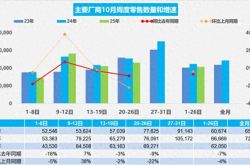Wu Yongming's Bold Bet: Investing 380 Billion Yuan in AI Infrastructure
![]() 02/28 2025
02/28 2025
![]() 547
547
@New Financial Insights
As the global AI competition evolves from a technological arms race to a contest of ecosystems and business models, every move by China's tech giants resonates deeply within the industry.
Two years ago, Baidu heralded the era of domestic large models with its bold proclamation of "All in AI," narrating a decade-long journey as an AI leader. Subsequently, ByteDance leveraged its financial might and saturation attacks to catch up, rewriting industry rules with an 80 billion yuan investment in Doubao. Now, amidst the lingering smoke of competition, Alibaba has quietly entered the fray, aiming to bring a fresh narrative to the market.
During a recent earnings call, Alibaba CEO Wu Yongming stated, "In the next three years, Alibaba will prioritize AI as a strategic core, increasing investment in AI infrastructure, basic model platforms, AI-native applications, and the AI transformation of existing businesses."
Wu Yongming further elaborated on this significant investment decision, planning to invest over 380 billion yuan in the next three years, with a focus on building cloud and AI hardware infrastructure. This figure not only surpasses Alibaba's total investment in this field over the past decade but also sets a record for the largest investment by a private enterprise in China.
This rare and detailed statement from Alibaba's top leadership, while seemingly radical, underscores the company's urgency to "catch up" in the AI era and its ambition to fully transform into a technology company.
In fact, the global market has already embarked on a new round of value reassessment for China's Internet technology enterprises. As an important bearer of Alibaba's technological attributes, Alibaba Cloud is also seen as a key driver. So, how will Alibaba leverage the virtuous cycle between AI and cloud businesses to form a positive growth flywheel in the current heated AI competition? What opportunities and risks lie ahead? When will Wu Yongming's blueprint come to fruition?
Alibaba Needs to Craft a Compelling New Story
"We believe that Alibaba Group may be one of the most important players in the AI field, with several key elements in the Asian market," Wu Yongming previously declared ambitiously.
This is a rare occurrence in recent years. Clearly, after Baidu and ByteDance made significant splashes, Alibaba has also decided to push into the limelight of AI this year, presenting the market with a new narrative.
In fact, Alibaba has already shown its intentions to go all in on AI last year. Beyond Tongyi Qianwen, the integration of large models with business and product sides has also commenced. However, the market's valuation logic for Alibaba has always centered on its e-commerce business. Some analysts have even bluntly stated that the market barely includes Alibaba's cloud computing and AI in its valuation.
Now, after DeepSeek's emergence has shattered the stereotype that China's AI technology lags behind the United States, the market's attention to Alibaba's second growth curve has intensified.
From Alibaba's recent actions, it is evident that it has a coherent AI narrative logic.
Firstly, product AI-ization. Unlike Tencent and Baidu, which aggressively use their core products, Alibaba's Quark and Tongyi Qianwen are standalone, purely AI-based products. Alibaba's other internal businesses, such as Taobao, Ele.me, and Flying Pigs, have been cautious in their AI-ization, and even the AI-ization of tool-based businesses like DingTalk and Gaode Maps is not apparent.
However, it cannot be denied that these Alibaba businesses have significant potential for AI transformation. AI-ization of e-commerce products can enhance consumer interaction, promote transaction efficiency, and increase user value, providing the possibility for growth in core businesses. As for productivity tools, their efficiency improvement is even more pronounced. The challenge for Alibaba lies in making a smooth transition.
Of course, compared to the general trend of product AI-ization, in the short term, Alibaba's greatest imagination lies in its role as an AI infrastructure provider.
As Wu Yongming pointed out, the business model for large foundational models is still unclear, but the cloud computing network, akin to the power grid in the electrical era, is the infrastructure of the AI era, with definite commercial returns. "90% of tokens will be generated and output on the cloud computing network in the future."
This is the core of Alibaba's 380 billion yuan investment. To achieve this scale in the next three years, at least 120 billion yuan will need to be invested annually, with quarterly investments around 30 billion yuan.
In fact, Alibaba has already begun to increase capital expenditures in this area in the last quarter. According to the financial report, capital expenditures in the last quarter were 31.8 billion yuan, an increase of approximately 260% year-on-year and 80% quarter-on-quarter, double the market expectation of 15.46 billion yuan. This increase is primarily due to increased spending on cloud infrastructure.
However, compared to other global tech giants, Alibaba's investment plan pales in comparison. For example, Amazon plans to spend $100 billion on AI by 2025, Microsoft $80 billion, Google $75 billion, and Meta Platforms $65 billion. More astonishingly, these are just the budget plans for 2025 alone.
Nonetheless, focusing on the present, the quarterly quota of 30 billion yuan is on par with the entire revenue of Alibaba Cloud, indicating that investment has been maximized. For Alibaba Cloud, as the differences between large models from various companies become smaller, opportunities are clear, but grasping them is not easy.
A High-Stakes Gamble with Both Opportunities and Risks
Objectively speaking, in the AI boom of the past two years, Alibaba's presence has not been prominent in various aspects. However, the success of DeepSeek not only verified the feasibility of the open-source route but also illuminated Alibaba's AI path.
Whether it's the Qwen model's open-source ecosystem and technical capabilities, Alibaba's investment in innovative companies like Moon's Dark Side, or its current "AI+Cloud" core strategy, these have accelerated its transformation from an "e-commerce company" to a "technology company" to a certain extent. Even its financial advantage enables it to secure a position in the large model race.
But this does not mean that Alibaba can rest easy in AI.
Firstly, at the application level, earlier this year, the Alibaba Group set "AI to C" as one of the group's overall focuses for 2025. In the C-end market for AI products, metrics such as user volume will be considered key dimensions, indicating that Alibaba has strong desires and requirements for its user scale and overall presence in the "AI to C" market.
"On the one hand, through products like Tongyi APP and Quark, we directly compete for users in the AI trend. On the other hand, we continue the AI-driven strategy of 2023, promoting the AI-ization of products like Tmall and Taobao, and we must see direct incremental benefits from AI within the year," said an insider.
It is worth noting that AI is transforming the distribution efficiency of core resources like traffic, and currently, all major companies are exploring how to reshape their businesses with AI. There will be new opportunities for reshuffling around users and merchants, and whether Alibaba can maintain its leadership will be crucial in 2025.
Additionally, although Alibaba's current AI All to C applications are limited to Quark and Tongyi, it is currently exploring a new round through product line integration and recruitment. Once the cooperation with Apple phones is finalized, it will also open up growth space for consumer-grade AI applications.
At the cloud service level, cloud vendors do not rely solely on selling APIs to generate revenue; the ultimate benefit stems from the scale of the entire cloud computing infrastructure. For cloud service providers like Alibaba Cloud, seizing the traffic entrance in the AI era is paramount. Multi-mode invocation on the cloud is already a major trend, and a more open mindset can attract more users. Once the API for invoking large models is locked into a cloud, subsequent consumption such as servers, storage, and application building will also be left to that vendor.
For developers and enterprises, there is no difference in which API to invoke, and ultimately, it comes down to price. In the absence of significant performance gaps, they tend to choose the cheaper option. Therefore, large companies have a clear price advantage. Moreover, under a prolonged price war and large-scale infrastructure investment over the next three years, Alibaba may face the dilemma of short-term profit margin decline.
Furthermore, specifically at the customer level, Alibaba Cloud's business is deeply influenced by the group's e-commerce genes, with a majority of customers from the e-commerce and retail industries. This dependence on internet customers makes Alibaba Cloud somewhat vulnerable when facing industry changes.
As the consumer internet gradually transitions to the industrial internet, and all industries undergo digital transformation and cloud migration, Alibaba Cloud, which has experienced multiple incidents in the past, does not have an advantage in terms of reputation.
Beyond connecting domestic chains, going overseas has also become a core issue for the domestic cloud computing industry. Starting from the Asia-Pacific region, leading domestic cloud service providers are gradually extending their business reach to various parts of the world, engaging in fierce competition with the world's top cloud service enterprises. For them, going overseas is not only an inevitable choice but also a crucial strategic decision.
It cannot be denied that Alibaba Cloud has already established its "cloud" brand overseas, especially in the Asia-Pacific market. However, the next step is to consider how to seize the crucial juncture of using AI to reverse market perception and leverage greater imagination in overseas markets.
From Slogan to Implementation: How Far is the Journey?
The capital market is both excited and cautious about Alibaba's AI story. The stock price has surged by more than 50% since the beginning of this year, seemingly recognizing the potential and possibilities of Alibaba in this new race, giving a positive response. However, behind this surging stock price, voices of doubt have never disappeared. The market still holds reservations about Alibaba's ability to truly translate its AI strategy into actual commercial value.
The reason is simple: if Baidu and ByteDance haven't been able to ground their stories, can Alibaba?
Looking back at the industry's development, Baidu first shouted the slogan of "All in AI" a decade ago. Its exploration in the AI field cannot be described as late, nor its investment small. ERNIE Bot, as an important achievement of Baidu in the large model field, carries the company's expectations for transformation in the AI era.
However, many years have passed, and Baidu is still struggling on the path of AI commercialization. Although ERNIE Bot has made certain progress at the technical level, it has consistently failed to meet expectations in terms of actual market application and commercial monetization. A large amount of upfront investment has failed to translate into matching revenue growth, forcing Baidu to transform and respond, leaving it in an awkward situation.
Leveraging its strong technical strength and abundant traffic resources, ByteDance quickly turned Doubao into the industry's "top pick," with astonishing user growth rates. However, in the fierce market competition, how to convert its huge user base into actual commercial benefits remains a major challenge.
Unlike Baidu and ByteDance, Alibaba has its unique "differentiated script," following the route of AI infrastructure. Therefore, for Alibaba, the key to this gamble lies in whether it can reconstruct AI infrastructure using the logic of "cloud as the power grid" to allow AI computing power demand to settle on its own cloud.
However, the current reality is that the revaluation of Alibaba Cloud's performance and the value of Alibaba's AI business and AI empowerment remains at the stage of theoretical logic and market sentiment, a process of "blowing bubbles." For Alibaba, the ultimate test of the success of its AI strategy lies in the delivery of performance.
In the view of "New Financial Insights," there are three key indicators to watch in 2025. Firstly, whether the revenue of AI-related products can maintain high growth directly reflects the commercial value and market recognition of Alibaba's AI technology. Sustained triple-digit growth means that Alibaba's AI products have strong competitiveness in the market, able to continuously attract new customers and maintain the loyalty of existing ones.
Secondly, whether Quark can become an application with hundreds of millions of users. As an important product of Alibaba in the AI era targeting the C-end market, Quark's monthly active user data is a crucial indicator to measure Alibaba's influence and commercialization prospects in the C-end market.
Finally, whether there can be a qualitative improvement in cloud revenue, which is also the focus of Alibaba's valuation logic and the essence of its AI narrative. When the market is still debating whether AI is a bubble or a revolution, Alibaba's strategic determination and resource investment demonstrate its potential for technological breakthroughs and market expansion.








